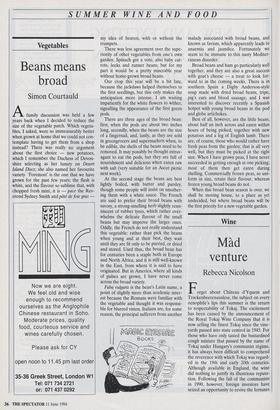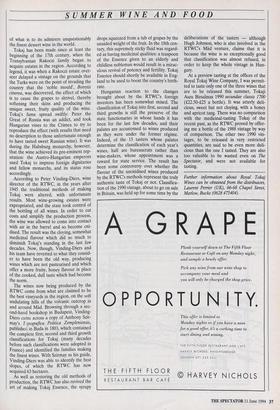Wine
Mad venture
Rebecca Nicolson
Forget about Château d'Yquem and Trockenbeerenauslese, the subject on every oenophile's lips this summer is the return to respectability of Tokaj. The excitement has been caused by the announcement of the Royal Tokaj Wine Company that it is now selling the finest Tokaj since the vine- yards passed into state control in 1945. For those who have only tasted the bastardised cough mixture that passed by the name of Tokaj under Hungary's communist regime, it has always been difficult to comprehend the reverence with which Tokaj was regard- ed in the 19th and early 20th centuries. Although available in England, the wine did nothing to justify its illustrious reputa- tion. Following the fall of the communists in 1990, however, foreign investors have seized an opportunity to revive the fortunes
SUMMER WINE AND FOOD
of what is to its admirers unquestionably the finest dessert wine in the world.
Tokaj has been made since at least the beginning of the 17th century, when the Transylvanian Rakoczi family began to acquire estates in the region. According to legend, it was when a Rakoczi estate over- seer delayed a vintage on the grounds that the Turks were on the point of invading the country that the 'noble mould', Botrytis cinerea, was discovered, the effect of which is to cause the grapes to shrivel, thereby softening their skins and producing the unique sweet, fruity quality of the wine. Tokaj's fame spread swiftly: Peter the Great of Russia was an addict, and took Hungarian vines to the Crimea to try to reproduce the effect (with results that need no description to those unfortunate enough to have tasted sweet Russian wine). It was during the Habsburg monarchy, however, that the wine achieved its pre-eminent rep- utation: the Austro-Hungarian emperors used Tokaj to impress foreign dignitaries and fellow monarchs, and its status rose accordingly.
According to Peter Vinding-Diers, wine director of the RTWC, in the years after 1945 the traditional methods of making Tokaj were altered, with unfortunate results. Most wine-growing estates were expropriated, and the state took control of the bottling of all wines. In order to cut costs and simplify the production process, the wine was allowed to come into contact with air in the barrel and so become oxi- dised. The result was the cloying, somewhat medicinal flavour which did so much to diminish Tokaj's standing in the last few decades. Now, though, Vinding-Diers and his team have reverted to what they consid- er to have been the old way, producing wines which are not pasteurised and which offer a more fruity, honey flavour in place of the cooked, dull taste which had become the norm.
The wines now being produced by the RTWC come from what are claimed to be the best vineyards in the region, on the soft undulating hills of the volcanic outcrop in and around Mad. Browsing through a sec- ond-hand bookshop in Budapest, Vinding- Diers came across a copy of Anthony Szir- may's Topografica Politica Zempleniensis, published in Buda in 1803, which contained the complete first, second and third growth classifications for Tokaj (many decades before such classifications were adopted in France) and identified the families making the finest wines. With Szirmay as his guide, Vinding-Diers was able to identify the best slopes, of which the RTWC has now acquired 63 hectares.
As well as restoring the old methods of production, the RTWC has also revived the art of making Tokaj Essence, the syrupy drops squeezed from a tub of grapes by the unaided weight of the fruit. In the 18th cen- tury, this supremely sticky fluid was regard- ed as having medicinal qualities: a teaspoon of the Essence given to an elderly and childless nobleman would result in a mirac- ulous revival of potency and fertility. Tokaj Essence should shortly be available in Eng- land to be used to boost the country's birth- rate.
Hungarian reaction to the changes brought about by the RTWC's foreign investors has been somewhat mixed. The classification of Tokaj into first, second and third growths is still the preserve of the state functionaries in whose hands it has been for the last few decades, and their palates are accustomed to wines produced as they were under the former regime. Indeed, of the 15 tasters whose palates determine the classification of each year's wines, half are bureaucrats rather than wine-makers, whose appointment was a reward for state service. The result has been some controversy over whether the flavour of the unoxidised wines produced by the RTWC's methods represent the truly authentic taste of Tokaj or not. Classifica- tion of the 1990 vintage, about to go on sale in Britain, was held up for some time by the deliberations of the tasters — although Hugh Johnson, who is also involved in the RTWC's Mad venture, claims that it is because the wine is so exceptionally good that classification was almost refused, in order to keep the whole vintage in Hun- gary.
At a preview tasting at the offices of the Royal Tokaj Wine Company, I was permit- ted to taste only one of the three wines that are to be released this summer, Tokaji Aszu Birsalmas 1990 secundae classis 1700 (£22.50-£25 a bottle). It was utterly deli- cious, sweet but not cloying, with a honey and apricot tang. There was no comparison with the medicinal-tasting Tokaj of the recent past, as the RTWC proved by offer- ing me a bottle of the 1988 vintage by way of comparison. The other two 1990 vin- tages, to be released in very restricted quantities, are said to be even more deli- cious than the one I tasted. They are also too valuable to be wasted even on The Spectator, and were not available for tasting.



































































 Previous page
Previous page